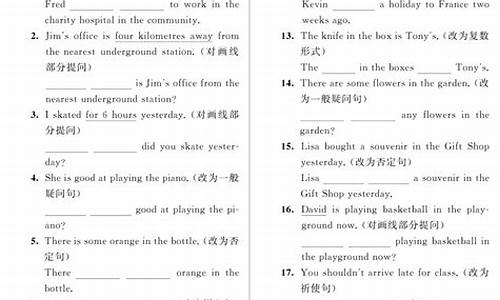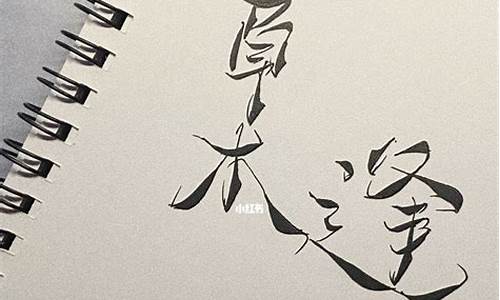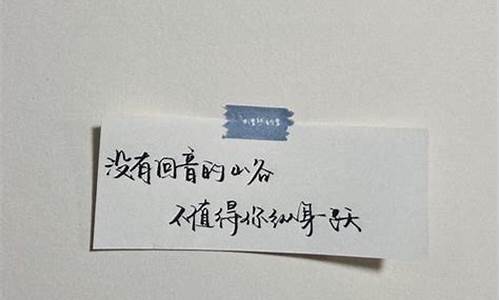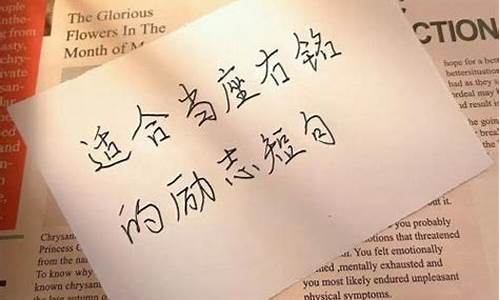您现在的位置是: 首页 > 经典语录 经典语录
句子结构专练_句子结构及例句
tamoadmin 2024-09-05 人已围观
简介1.英语中的句子成分详解加练习2.大学英语听力技巧3.这个句子的语法结构是什么?4.句子成分说明5.句式结构问题他(主语)非常诚恳的(状语)征求(谓语)大家的(定语)意见(宾语)汽车(主语)在望不到边际的高原上(状语)奔驰(谓语)峰峦(主语)刚刚从黑夜中(状语)显露出(谓语)一片灰蒙蒙的(定语)轮廓(宾语)豆大的(定语)汗珠(主语)不停地从脸上直往下(状语)落(谓语)我们村里的(定语)农民(主语)
1.英语中的句子成分详解加练习
2.大学英语听力技巧
3.这个句子的语法结构是什么?
4.句子成分说明
5.句式结构问题

他(主语)非常诚恳的(状语)征求(谓语)大家的(定语)意见(宾语)
汽车(主语)在望不到边际的高原上(状语)奔驰(谓语)
峰峦(主语)刚刚从黑夜中(状语)显露出(谓语)一片灰蒙蒙的(定语)轮廓(宾语)
豆大的(定语)汗珠(主语)不停地从脸上直往下(状语)落(谓语)
我们村里的(定语)农民(主语)往冻土上(状语)铺了(谓语)一层(定语)麦秸(宾语)
小学校(主语)显(谓语)得那样幽静而又神秘(补语)
鲁班(主语)发现(谓语)这种草药的两边都长着锯齿状的刺(宾语)
划分了成分,主杆自然就找出来了,主语谓语宾语是主杆,其它是枝叶。
英语中的句子成分详解加练习
主谓宾状结构的英语句子如下:
1、He ran down the street, shouting for help.(主谓+宾+状)
2、She drove to work, listening to music.(主谓+状+宾)
3、They finished the project, working late into the night.(主谓+宾+状)
4、The teacher named me Lucy.(主谓+补)
5、Very loud noises can make people ill.(主+状)
6、She looks nice.(主+表)
7、Ann is in the classroom.(主+介词短语)
8、My friend is a middle school student.(主+定语)
9、The man with black glasses liked sweet food.(主+定语)
10、Bruce speaks English very well.(主+状语)
学习英语的技巧:
1、听力训练
听力是学习英语的基础,如果没有听力的支持,就无法与英语母语者进行交流。因此,要提高英语水平,首先需要加强听力训练。可以通过听英语新闻、英语电视剧、英语歌曲等方式,训练自己的听力能力。
2、阅读积累
阅读是学习英语的重要途径,通过阅读可以积累词汇、语法和文化知识。可以选择一些英语原版的书籍、文章、新闻等,提高阅读水平。在阅读中,要注意词汇的含义和用法、语法的正确性和上下文的逻辑关系,逐渐积累英语语言知识和文化背景知识。
3、口语练习
口语是学习英语的关键,只有掌握好口语才能与英语母语者进行流畅的交流。可以通过模仿、对话、演讲等方式,提高自己的口语能力。在口语练习中,要注意语音语调、发音规则等细节,要掌握常用的英语表达和交际技巧,逐渐提高自己的口语水平。
大学英语听力技巧
英语:句子的组成部分,包括主语、谓语、宾语、定语、补语、状语、表语七种 主语是句子叙述的主体,可由名词、代词、数词、名词化的形容词、不定式、动名词和主语从句等来承担。 谓语说明主语所发出的动作或具有的特征和状态。谓语由动词来承担。 宾语是动作的对象或承受者,常位于及物动词或介词后面。宾语可由名词、代词、数词、名词化的形容词、不定式、动名词、宾语从句等来担任。 主语和谓语是英语句子的两大成分,除少数句子(如祈使句和感叹句等)外,一句话必须同时具有主语和谓语所表达的意思才能完整。主语是针对谓语而言的,是一句话的主题,谓语用来说明主语的情况,为主语提供信息。例如:They are working.主语是they(他们),那么他们在做什么呢?看来没有谓语are working 是不行的。在正常情况下,英语的主语和谓语的位置与汉语一致,也就是说主语在前,谓语紧跟其后。那么,哪些词语可以做主语,谓语,何时主谓倒置,主语与谓语的一致情况如何,我将一一讲述。 主语 定义:主语是句子陈述的对象,说明是谁或什么。表示句子说的是"什么人"或“什么事”。主语是执行句子的行为或动作的主体。 哪些词可以充当主语 1,名词 例如: A mooncake is a delicious, round cake. The first truck is carrying a few baskets. The temperature will stay above zero. The doctor looked over Mrs. Brown very carefully. China does not want to copy the USA’s example. 2,代词 例如: It’s a young forest. I don’t know if it will grow. That’s a bit expensive. You’d better buy a new pair. I’m afraid we hen’t got any black shoes. 3,数词 例如:One and two is three. One is not enough for me. I want one more. One of them is English. Suddenly one of the bags fell off the truck. Two will be enough. 4,不定式 (常以 It’s adj. to do sth. 形式出现) 例如: To give is better than to receive =Its better to give. I found it difficult to get to sleep. It’s glad to see you again. It was difficult to say. But it’s good to swim in summer. 5,IT 作主语,有如下情况: 1)指代刚刚提到的事物:What’s this ? It’s a bus. (指代what) 2)指代一个你不知道或判断不清性别的人:Who’s knocking the door? It’s me. (指代 who) Who’s the baby in the picture? It’s my sister. (指代 who) 3) 表示时间,天气,距离: What’s the time? It’s eight o’clock. (时间) What’s it going to be tomorrow? It’s going to be rainy.(天气) How far is it? It’s about one kilometre away. (距离) 6. THERE 引起的There be 句型中,be 作谓语,主语位居其后。如: There are many different kinds of mooncakes. There will be a strong wind. 谓语 谓语由动词构成,依据其在句中繁简程度可把谓语分为简单谓语和复合谓语两类。不论何种时态,语态,语气,凡由一个动词(或动词词组)构成的谓语都是简单谓语。例如: I like walking.(一般现在时主动语态) I made your birthday cake last night. (一般过去时主动语态) It is used by trellers and business people all over the world. (一般现在时被动语态) 复合谓语也可分为两种情况: 第一种是由情态动词,助动词+不带to的动词不定式构成的复合谓语: What does this word mean? I won’t do it again. I’ll go and move away the bag of rice with Lin Tao. You’d better catch a bus. 第二种是由连系动词+表语构成的复合谓语。例如: You look the same. We are all here. The weather gets wamer, and the days get longer. Keep quite and listen to me. He looked worried. We he to be up early in the moming. Is Bill in? School Is over. Let’s go home. My pen is in my bag. I feel terrible. I* fell tried all the time. He seemed rather tired last night. 连系动词和表语在意思上紧密联系,不宜分割;有关动词的种类这方面知识在课本中已有介绍,此处不多说了。 宾语 宾语是谓语动作所涉及的对象,它是动作的承受者,宾语可以由名词或起名词作用的成分担任,宾语一般放在谓语动词后面。 I saw a cat in the tree. 我看见树上有一只猫。 I want to go shopping. 我想去买东西。 He said he could be here. 他说他会来的。 We think you are right. 我们认为你是对的。 有些及物动词可以有两个宾语,其中一个宾语多指人,另一个宾语指物,指人的宾语叫做间接宾语,指物的宾语叫做直接宾语,可以带两个宾语的动词有 bring,give,show,send,pass,tell等。间接宾语一般放在直接宾语的前面,如果强调直接宾语可把直接宾语放在间接宾语的前面, 但间接宾语前须加"to"。 My father bought me a book. 我父亲给我买了一本书。 Give the rubber to me. 把橡皮给我。 Please give the letter to XiaoLi. 请把这封信给小李。 有些及物动词除跟一个宾语外,还需要加上宾语补足语,否则意思不完整,它们一起构成复合宾语,复合宾语中宾语和后面的宾语补足语有一种逻辑上的主谓关系,这也是判断是两个宾语还是复合宾语的依据,宾语可以由名词或起名词作用的词担任。 We all call him LaoWang. 我们都叫他老王。 Please color it red. 请给它涂上红颜色。 We found the little girl in the hill. 我们在山上找到了小女孩。 定语 用于描述名词,代词,短语或从句的性质,特征范围等情况的词叫做定语,定语可以由名词,形容词和起名词和形容词作用的词,短语担任。如果定语是单个词,定语放在被修饰词的前面,如果是词组,定语放在被修饰词的后面。 That is a beautiful flower. 那是一朵漂亮的花。 The TV set made in that factory is very good. 那个工厂生产的电视机很好。 This is my book,not your book. 这是我的书,不是你的书。 There are more than twenty trees in our school. 我们学校里有二十多棵树。 I he a lot of things to do. 我有好多要做的事情。 Our country is a developing country. 我们的国家是一个发展中的国家。 状语 1、说明事物发生的时间,地点,原因,目的,结果方式,条件或伴随情况,程度等情况的词叫状语。 2、状语的功用:状语说明地点、时间、原因、目的、结果、条件、方向、程度、方式和伴随状况等。 3、状语一般由副词、介词短语、分词和分词短语、不定式或相当于副词的词或短语来担当。其位置一般放在句末,但也可放在句首或句中,修饰动词、形容词、副词等 A、副词一般在句子中做状语. He speaks English very well. 他英语说得非常好. He is playing under the tree.中的under the tree是地点状语. B、不定式在句子中可以作目的状语。 I come specially to see you.我专门来看你. C、介词短语 Ten years ago, She began to live in Dalian. The boy was praised for his brery. D、从句作状语 When she was 12 years old, she began to live in Dalian. If I am not busy tomorrow, I will play football with you. E、分词作状语 Hing had a quarrel with his wife, he left home in a bad temper。 Inhibited in one direction, it now seems that the Mississippi is about to take another. 补语 英语中补语的作用对象是主语和宾语,具有鲜明的定语性描写或限制性功能,在句法上是不可或缺的。补语是起补充说明作用的成份。最常见的是宾语补足语。名词、动名词、形容词、副词、不定式、现在分词、过去分词都可以在句子中作宾补。 1、主语的补语 它用在系动词后,是句子的一个基本成分。常用主-系-表结构。 1.I saw her with them, at least, I thought it was her. 我看到她和他们在一起,至少,至少我认为是她。(her做宾 语,them做介词宾语,her做主语补语) 2.. -- Who broke the vase? --谁打碎了花瓶? -- Me. --我。 (me做主语补语= It's me.) 3.John hoped the passenger would be Mary and indeed it was she. (she做主语补语) 约翰希望那位乘客是玛丽,还真是她。 2、宾语的补语 1.不定式(to do) Father will not allow us to play on the street. 父亲不让我们在街上玩耍。 We believe him to be guilty. 我们相信他是有罪的。 We made him copy the sentence. He is made to copy the sentence. I felt my hands tremble. 2.名词 At the meeting we elected him monitor. I think your brother a clever boy. 3.形容词 What you said made Xiao Wang angry. I found the classroom empty 4.副词 Please call the students back at once. He was seen to take his cap off. 5.现在分词 We hear him singing in the hall. I found him lying in bed, sleeping. 6.过去分词 He saw his face reflected in the water. I heard it spoken of in the next room. 表语 表语是用来说明主语的性质,身份,特征和状态。表语须和连系动词一起构成句子的复合谓语。表语一般放在系动词之后。表语可以由名词,形容词或起名词和形容词作用的词和短语担任。 These desks are yellow. 这些桌子是**的。 I am all right. 我没事。 We are hy now. 我们现在很幸福。 It's over. 时间到了。 She is ten. 她十岁了。 My work is teaching English, 我的工作是教英语。 The dictionary is in the bag. 词典在书包里边。 My question is how you knew him. 我的问题是你如何认识他的。 同位语 当两个指同一事物的句子成分放在同等位置时,一个句子成分可被用来说明或解释另一个句子成分,前者就叫做后者的同位语(ositive).这两个句子成分多由名词(代词)担任,同位语通常皆放在其说明的名词(代词)之后。 This is Miss Chen, our English teacher. 这是陈**,我们的英语老师。 My parents both are teacher. 我父母俩都是老师。 We all like sports. 我们都喜欢运动。
这个句子的语法结构是什么?
英语听力并不是听的时间越长就越好,而是需要效率,时间太长只会让你觉得耳朵变得迟钝,大脑反应变慢。下面是我收集的大学英语听力技巧,欢迎大家收藏。 大学英语听力技巧总结 模仿语音策略: 听音困难主要是因为头脑中单词的形与音不匹配造成的。如果你的发音与录音材料中的发音不一致,即便你认识该单词,也很难听出来。在正常语速中,很多单词的发音发生异化。常见的异化有连读和失去爆破。连读指以辅音结尾的单词与以元音开头的单词相邻时会发生的读音变化, 扩展资料
英语听力并不是听的时间越长就越好,而是需要效率,时间太长只会让你觉得耳朵变得迟钝,大脑反应变慢。下面是我收集的大学英语听力技巧,欢迎大家收藏。
大学英语听力技巧总结
模仿语音策略:
听音困难主要是因为头脑中单词的形与音不匹配造成的。如果你的发音与录音材料中的发音不一致,即便你认识该单词,也很难听出来。在正常语速中,很多单词的发音发生异化。常见的异化有连读和失去爆破。连读指以辅音结尾的单词与以元音开头的单词相邻时会发生的读音变化,如feel it的读音会变成/fi:lit/。失去爆破指当前一个单词的尾音和后一单词的首音为b, p, d, t,k等爆破音或破擦音时,前一单词的尾音把气流堵在里面,但不爆破,直接发出后词的首音。如good night听上去就像/gu’nait/。此外还有弱读(即不重要的或没有具体意义的单词发音很轻)等现象。
数字练习策略:
对数字反应较慢一般是因为练习不够造成的。除了对数字进行专项练习外,还要总结数字题的一些规律。 数字题有几种常见形式:一种是作为数量的数字,如数、量、时间等。由于英语的数字表达方式与中文不同,听到的英文数字需要快速转化,如从ten thousand转化为1万。 其次,电话号码类的数字。英语的电话号码一般在前三位数字读完会有个停顿,如6534210 读成653-4210。 还有一种是门牌号。一般会有个No.或Room在前面。 如果在听数字上有较为突出的问题,最好找一些数字题,进行专项练习。
句型结构练习策略:
遇到句子反应不过来或者听不懂长句的情况,大多是因为对口语的句型缺乏了解造成的。对此,在练习听力时,多注意听力材料中常见的句型,并把这些句型记下来。听到反应不过来的句子,多听几遍,找出句子的结构。逐步地就能提高听句子的能力了。
文化知识策略:
地名、人名或其它专有名词都有着丰富的文化内涵,只有对文化加强了解,才能快速地反应出这些内容。因此,必须多积累以下方面的文化知识:常见的英语人名、人名拼读规则、常见的地名、重要城市名、历史朝代、重要***或重要政治人物名、重大政治和文化历史名等。有了这些背景知识,语音加工的负担就能得到减轻,哪怕只听到一个大概,也能猜测出是什么内容了。
怎么提高英语听力
要提高听力首先要提高你的阅读基础(包括词汇量,语法基础),阅读基础越好,能看得懂的东西越多,听力也会越顺畅,努力听懂能读得懂的东西,听懂该听懂的,根据自己的实际水平(可以大致等同于词汇量水平)选择合适的听力材料;
初级精听
我们的练习目标是能够听懂词、词组、较短的句子,关注发音,学习重音、弱读等,使用听写的方法,具体操作以句子或分句为单位听,要听懂所有内容,写下来要精确到一个字母和一个标点。
高级精听
仍然使用听写的方法,具体操作,以多句听写为单位,听多遍,但一定要多句一次听,从一句逐步增长到两句、三句,我们坚持练习,达到听三遍写下6句话或30秒内容就差不多了;
听力融合理解
这个时候专注理解句子的意义,选择材料的难度要适中,个别不能听懂的地方需要停下来听写,达到听整篇文章后理解前后段、前后句的关系;
尝试进行口语翻译
调整听力材料的速度,把原来能听懂的材料调整到1.2倍速度,甚至1.5速度,进行不断的进行精听,还要学会做笔记;
进行泛听
泛听应该放在精听之后,作为精听的一种补充,泛听是拓宽知识面,这个时候不必要去认真的听每一个句子,只要大概明白其中的意思就可以
英语听力技巧方法
1、泛听
在练习听力之初,我们可以以多听为主。除了课堂教学,我还努力通过“潜移默化式”英语学习法。在家里,家长们可以让孩子充分利用一切课余时间去学习英语。如在孩子们起床时、早饭时、晚饭后、洗澡时、睡觉前等等一切可以利用的时间,播放英文录音或者歌曲,反复听,随意听。学生渐渐地对内容熟悉了,自然而然耳朵就习惯了听英语。给予孩子一个最缺少的自然的英语环境,他们自然而然就会对英语产生兴趣,学习效果也会非常明显。
2、听力,语音相辅
有了泛听的基础,我们就要进一步考虑如何提升听力的质量。在实际授课过程中,我发现,学生最难把握的语音点通常是连读和停顿。往往学生能听懂的是一些单词,可当其置于句中、融入语篇时,便出现了很多问题。
连读: 英语的句速是由重音的间距来决定的,有时在一拍时间内要连续发多个音,于是单词与单词之间就需要首尾相连,由前一个单词的末尾音节与后一个单词的起首音节相连, 这就构成了连读。如:Can I he a look? / there is / look at it.停顿: 英语的节奏有一个显著特点就是需要停顿。这在学生的日常发音中常常被忽略。很多学生以为一气呵成的快速朗读就是所谓的流利。其实不然。这不仅不符合日常的口头表达方式,给听者带来理解上的困难,也影响了自己的听力。英语的停顿是为了增强语言的感染力和表现力,便于更好地表达说话人的思想感情,引起听者的共鸣,同时也突出了语言的旋律美和节奏美。有些学生在进行听力训练时,误将句中的停顿听成是句与句的停顿,不能正确地把前后部分关联起来,结果错误地理解全篇内容。所以我们在听的时候,要注意听其语音语调,有意识地记忆与模仿。这样可以丰富我们的听力知识,同时能够提高我们听力的准确率。
3、注意听力技巧
很多孩子在做听力的时候,经常会想要听清每一个单词。然而在听力练习中,这样的习惯会让孩子在错过一个单词后,后面的内容会全部来不及听
起初孩子们很不适应这样的听力练习方式,一般会出现两种情况:一是遇到不理解的听不出来的单词,一直在纠结怎么写;二是听到关键词马上开始写,而导致后面的内容完全没有听到。
所以针对这样的情况,遇到一时不理解的单词不要停下来思索,而要坚持继续听,以防止错过更多的信息。另外,我们在听到会的单词后,可以在线上先写出该单词的首字母,提醒自己。在完全听完录音后,在逐一补全。
大学英语听力教学的方法
适当做一些听写练习
另外一个能提高学生听力理解能力的方式就是做一些听写练习,特别是对一些只通过读写方式而非听的方式学习外语的学生来说,他们在分辨与认识发音上有很大的障碍。通过听写练习,他们可以有很大的`收获。比如,材料中如果存在很多同音词,学生就必须更加注意,他们会通过全篇材料去理解这些同音词的意思。通过这种练习,可以在训练听力的同时,加强他们拼读与写的能力。如果经常使用这种训练方式,将会给学生的英语学习带来极大的帮助。当然,听写的材料不宜太长,难度应合适,否则学生会感觉超出了他们的理解范围或者超出了他们的兴趣范围,可能会产生厌烦心理甚至排斥心理。所以,选择合适的材料做合适的练习,才能有效地提高学生的听力理解能力。
教会学生抓住重点
通常,学生们喜欢把材料里的每个单词都理解清楚。事实上,不同的听力材料在不同的语速下,大部分学生特别是听力能力不是很好的学生,想听懂每个单词基本上是不可能的。对于这些学生而言,要把每个单词都听清楚并弄懂它的含义,往往可能会顾此失彼,赶不上听力内容的速度,只能抓住其中的部分意思。甚至有的学生由于过于纠结于某个单词的意思而错过了听力材料的大部分内容,得不偿失。所以总的来讲,只要学生能把听力材料的重点,即能帮助理解材料的内容听懂并理解就可以了。一般来说,一篇材料里的诸多新单词并不会影响学生理解全篇大意。所以教师应当经常提醒学生要听重点,根据问题留意某些细节就可以了,教会学生如何抓住听力材料的重点。
营造轻松的语言学习氛围
良好的语言学习氛围是很重要的。在课堂上,教师应尽量使用简单易懂的英语来训练学生的听力。一般来说,学生在刚开始听力训练的时候会有一些困难。教师不妨用一些汉语和肢体语言来帮助学生克服困难。然后循序渐进,当学生的听力能力提高后,教师可逐步增加英语的量,直至完全使用英语来授课,这样有利于营造一个轻松的语言学习氛围。同时,也不会因为难度过大而打击学生的学习积极性与自信心。培养与保持学生的自信也是英语教学中非常重要的一环,只有自信的学生才能更加轻松地融入第二语言的学习中去。
句子成分说明
A fundamental property of any electronic or electrical circuit is that the voltages present within it are referenced to a common point, conventionally called the ground.定语从句[注意:关系词一般紧跟在先行词之后引导定语从句。定语从句总在被修饰的先行词后面。定语从句: 在复合句中修饰名词或代词的句子在复合句中充当定语,所以叫作定语从句。
先行词: 定语从句所修饰的名词或代词。
关系词: 引导定语从句的词,分为关系代词(who,whom,that,which,whose)和关系副词(where,when,why,)。
复合句 : The man who (that) came is Mike.
先行词 关系代词
Li Ming is the one that got full marks in our class.
先行词 关系代词
上句的黑体字为复合句中的主句,蓝体字为定语从句.
一 定语从句的关系代词 Which的用法: 若先行词指物则代替先行词在定语从句中充当主语或宾语.
This is the pen which was given by my friend.
先行词 指物代替先行词在定语从句中充当主语
This is the pen which my friend ge to me.
先行词 指物代替先行词在定语从句中充当宾语
二 定语从句的关系代词 Who的用法: 若先行词指人则代替先行词在定语从句中充当主语或宾语(如果前面带介词则必须用whom)
The man who is wearing a white suit is my brother.
先行词 指人代替先行词在定语从句中充当主语
The man who\whom he wanted to see last week is in Shanghai.
先行词 指人代替先行词在定语从句中充当宾语
She is the girl with whom I went there.
先行词 指人代替先行词在定语从句中充当介宾且介词于前.
三 定语从句的关系代词 Whom的用法: 若先行词指人则代替先行词在定语从句中充当宾语(包括介词的宾语) ,与who的区别是如果前面带介词则必须用whom
This is the teacher whom\who we like best.
先行词 指人代替先行词在定语从句中充当宾语
She is the girl whom\ who I went with there.
先行词 指人代替先行词在定语从句中充当介宾.
I don’t like the boy to whom you are talking.
先行词 指人代替先行词在定语从句中充当介宾且介词于前.
四 定语从句的关系代词 that的用法: 若先行词指人或物则代替先行词在定语从句中充当主语或宾语
The animal that \which is lost is a panda.
先行词 指物代替先行词在定语从句中充当主语
She is the person that \who we are worried about.
先行词 指人代替先行词在定语从句中充当宾语
注意1 that \which在代物时常常可以通用,但有时只宜于用which ,不用that
(1) 关系代词前有介词时.
This is the hotel in which you will stay.
(2) 如有两个定语从句,其中一句的关系代词是that,另一句宜于用which.
Let me show you the novel that I borrowed from the liberary which was newly open (新开放) to us.
注意2that \which在代物时常常可以通用,但有时只宜于用that ,不用which.
(1) 先行词是形容词最高级或者它的前面有形容词最高级时
This is the best that has been used against air pollution(反对空气污染) in cities.
English is the most difficult subject that you will learn during these years.
(2) 先行词是序数词,或它的前面有一个序数词时
He is the last person that I want to see.
(3) 主句中已有疑问词时
Which is the bike that you lost?
(4) 先行词既有人又有物时
The bike and its rider that had run over (撞倒了)an old man were taken to the police station.
(5) 先行词是all,much,little,something,everything,anything,nothing,none,the one等代词时
You should hand in all that you he.
We hen’t got much that we can offer you.
I mean the one that you talked about just now.
(6) 先行词前面有only,any,few,little,no,all,one of,the same,the very等词修饰时
The only thing that we can do is to give you some money.
Li Ming is the only one that got full marks (满分)in our class.
Li Ming is one of the students that want to be teachers in our class.
(7) 有两个定语从句,其中一个关系代词已用which,另外一个宜用that
Edison built up a factory(办了一个工厂) which produced things that had never been seen before.
定语从句的关系副词 Where的用法:若先行词指地点且其在定语从句中充当地点状语.
This is the house+I was born in the house. (=I was born there)
介词短语 副词
=This is the house where I was born.这就是我在那儿出生的房子.
先行词 关系副词
in which I was born.
介词+关系代词
which I was born in.
关系代词
这里作介宾的which和that可以省略
that I was born in
关系代词.
练习:用which ,where填空
1 This is the factory where they want to visit。
2 My sister works in a bookshop in which we can read many kinds of books
3 He you visited the city where the famous scientist was born?
4 Is this the museum which they visited last month?
5 He built a telescope through which he could study the skies.
6 The pencil with _which_______ he wrote was broken.
7 Is this the shop _which____ sells children’s clothing?
8 I still remember the sitting-room _where____ my mother and I used to sit in the evening.
9 Don’t go in, this is the shop _which____ we he just been to。
10 Please show me the book _which____ you bought yesterday _____.
二 定语从句的关系副词 When的用法: 若先行词指时间且其在定语从句
中充当时间状语.
He came at a time +we needed help at a time.
介词短语
=He came at a time when we needed help
关系副词
at which we needed help
介词+关系代词
which we needed help at
关系代词 这里的作介宾的which 和that可以省略
that we needed help at
三 关系副词why的用法:在定语从句中只要先行词是the reason,它的关系副词就是why。
如:The reason why I’m calling you is to invite you to the party.
句式结构问题
句子成分
主语(subject): 句子说明的人或事物。
The sun rises in the east. (名词) He likes dancing. (代词)
Twenty years is a short time in history. (数词) Seeing is believing. (动名词)
To see is to believe. (不定式) What he needs is a book. (主语从句)
It is very clear that the elephant is round and tall like a tree. (It形式主语,主语从句是真正主语)
谓语(predicate): 说明主语的动作、状态和特征。
We study English. He is asleep.
表语(predicative): 系动词之后的成分,表示主语的性质、状态和特征。
He is a teacher. (名词) Seventy-four! You don’t look it. (代词)
Five and five is ten. (数词) He is asleep. (形容词)
His father is in. (副词) The picture is on the wall. ( 介词短语)
My watch is gone / missing / lost. (形容词化的分词)
To wear a flower is to say “I’m poor, I can’t buy a ring. (不定式)
The question is whether they will come. (表语从句)
(常见的系动词有: be, sound(听起来), look(看起来), feel(摸起来,smell(闻起来), taste(尝、吃起来),
remain(保持,仍是), feel(感觉) ...
It sounds a good idea. The sound sounds strange.
Her voice sounds sweet. Tom looks thin.
The food smells delicious. The food tastes good.
The door remains open. Now I feel tired.
宾语:1)动作的承受者-----动宾
I like China. (名词) He hates you. (代词)
How many do you need? We need two. (数词)
We should help the old and the poor. I enjoy working with you. (动名词)
I hope to see you again. (不定式) Did you write down what he said? (宾语从句)
2) 介词后的名词、代词和动名词-----介宾
Are you afraid of the snake? Under the snow, there are many rocks.
3) 双宾语-----间宾(指人)和直宾(指物)
He ge me a book yesterday. Give the poor man some money.
宾补:对宾语的补充,全称为宾语补足语。
We elected him monitor. (名词) We all think it a pity that she didn’t come here. (名)
We will make them hy. (形容词) We found nobody in. ( 副词 )
Please make yourself at home. 介词短语) Don’t let him do that. (省to不定式)
His father advised him to teach the lazy boy a lesson. (带to不定式)
Don’t keep the lights burning. (现在分词) I’ll he my bike repaired. (过去分词)
主补:对主语的补充。
He was elected monitor. She was found singing in the next room.
He was advised to teach the lazy boy a lesson.
定语:修饰或限制名词或代词的词、词组或句子。
Ai Yanling is a chemistry teacher.(名词) He is our friend. (代词)
We belong to the third world. (数词) He was advised to teach the lazy boy a lesson.(形容词)
The man over there is my old friend.(副词) The woman with a baby in her arms is my sister. (介词)
The boys playing football are in Class 2. (现在分词)
The trees planted last year are growing well now. (过去分词)
I he an idea to do it well. (不定式)
You should do everything that I do. (定语从句)
状语:用来修饰v., adj., adv., or 句子。 表示时间、地点、原因、目的、结果、程度、条件、方式和让步。
(以下例句按上述顺序排列)
I will go there tomorrow. The meeting will be held in the meetingroom.
The meat went bad because of the hot weather. He studies hard to learn English well.
He didn’t study hard so that he failed in the exam. I like some of you very much.
If you study hard, you will pass the exam. He goes to school by bike.
Though he is young, he can do it well.
句子结构
简单句的五个基本句型
主语 + 不及物动词 She came./ My head aches.
主语 + 及物动词 +宾语 She likes English.
主语 + 系动词 +主语补语 She is hy.
主语 + 双宾动词 +间接宾语 +直接宾语 She ge John a book.
She bought a book for me.
主语 + 宾补动词 + 宾语 + 宾语补语 She makes her mother angry.
The teacher asked me to read the passage.
( There +be There lies a book on the desk. )
Exercises
分析下列句子成分
1. Our school is not far from my home. 2. It is a great pleasure to talk with you
3. All of us considered him honest. 4. My grandfather bought me a pair of sports shoes.
5. He broke a piece of glass. 6. He made it clear that he would lee the city.
7. ---I love you more than her,child . 8. Tees turn green when spring comes.
9. They pushed the door open. 10. Grandma told me an interesting story last night.
11. He wrote carefully some letters to his friends. 12.All the students think highly of his teaching
13. We need a place twice larger than this one. 14. He asked us to sing an English song.
15. Don't get nervous,help yourself to what you like.16.We will make our school more beautiful.
17. He didn't come.That is why he didn't know. 18. She showed us her many of her pictures.
19. The old man lives a lonely life.
20. Luckily the 1989 earthquake did not hen in the center of town.
21. The cars made in Japan are better than those in Germany.
22. There are so many people in the hall that it's hard for me to find him.
23. No matter how difficult the task may be, we must fulfil it this month.
24. Go back where you came from. 25. We must do whatever the people want us to do.
26. At last he got home, tired and hungry. 27. Would you please pass me the cup?
28 Mary handed her homework to the teacher. 29. Do you know the latest news about him?
30. I’ll get my hair cut tomorrow.
翻 译 练 习:
主谓结构 ( 主语 + 不及物动词 )
1你应当努力学习。 2她昨天回家很晚。
3那天早上我们谈了很多。 4会议将持续两个小时。
5在过去的十年里,我的家乡已经发生了巨大的变化。
6这种事情全世界各地每天都在发生。
7 1919年,在北京爆发了“五.四”运动。
8每天八时开始上课。 9这个盒子重五公斤。
10五年前我住在北京。
主谓宾结构 (主语 +及物动词 +宾语 )
1昨晚我写了一封信。 2今天下午我想同你谈谈。
3这本书他读过多次了。 4他们成功地完成了。
5你们必须在两周内看完这些书。 6那位先生能流利地说三种语言。
7我收到了笔友从澳大利亚寄来的信。
8 Jim 还不会自己穿衣服。
9我们大家都相信Jack 是一个诚实男孩。
10他不知道说什麽好。
主系表结构 (主语 +系动词+表语 )
1我的兄弟都是大学生。 2冬季白天短,夜晚长。
3布朗夫人看起来很健康。 4十五岁他就成为有名的钢琴家了。
5孩子们,请保持安静。 6这本书是有关美国历史的书。
7她的工作是在幼儿园里照看儿童。 8他失业了。
9树叶已经变黄了。 10这个报告听起来很有意思。
双宾语结构 (主语+双宾动词+间接宾语+直接宾语 )
1 Johnson 先生去年教我们德语。 2. 奶奶昨晚给我们讲了一个有趣的故事。
3. Mary把钱包交给校长了。 4. 请把那本字典递给我好吗?
5. 他把车票给列车员看。 6. 这个学期我已经给父母写过三封信了。
7. 我父亲已经给我买了一辆新自行车。 8. Robinson Crusoe 给自己做了一只小船。
9. 请你给我弄一本新的,好吗? 10. 我替你叫辆出租汽车好吗?
复合宾语结构 (主语 +动词 + 宾语 + 宾语补足语 )
1我们叫她Alice. 2他的父母给他取名为John.
3我们大家都认为他是诚实的。 4他们把门推开了。
5他们把小偷释放了。 6我们要使学校变得更美丽。
7他请我们参加做游戏。 8我要你把真相告诉我。
9卫兵命令我们立即离开。 10明天我要找人来修理机器。
11每天早晨我们都听到他大声朗读英语。 12痛苦使得他叫喊起来。
13我们不会让她在晚上外出的。 14他每个月理一次发。
15我要请人把我的录音机修理一下。 16那可怕的声音把孩子们吓坏了
17她正在听人家讲故事。 18男孩子们都在看士兵们操练。
19我从来没看见这个字这样用过。 20他感到很难跟你交谈。
21我想乘船去那里更舒服些。 22我认为有可能用另一种方法解题。
23学校定了一条规则,开始上课时学生要起立。 24我认为与那个人谈话是无益的。
There be 句型
1今晚没有会。 2这个村子过去只有一口井。
3这个学校有一名音乐老师和一名美术老师。 4客人当中有两名美国人和两名法国人。
5天气预报说下午有大风。 6灯亮着,办公室里肯定有人。
7战前这儿一直有家**院的。 8恰好那时房里没人。
9从前,在海边的一个村子里住着一位老渔夫。 10公共汽车来了。
11就只剩下二十八美元了。 12在这个山洞前面长着一棵高大的松树。
13铃响了。 14二月份有二十八天。
KEYS
分析下列句子成分
1. 主语 + 系动词 + 表语 2. 主语 + 系动词 + 表语
3. 主语 +动词 + 宾语 + 宾语补足语 4. 主语+双宾动词+间接宾语+直接宾语
5. 主语 +及物动词 +宾语 6. 主语 +动词 + 形式宾语 it+ 宾语补足语+宾语
7. 主语 +及物动词 +宾语 8. 主语 + 系动词 + 表语
9. 主语 +动词 + 宾语 + 宾语补足语 10. 主语+双宾动词+间接宾语+直接宾语
11. 主语+双宾动词+间接宾语+直接宾语 12 主语 +及物动词 +宾语
13. 主语 +及物动词 +宾语 14. 主语 +动词 + 宾语 + 宾语补足语
15. 主语 + 系动词 + 表语 16. 主语 +动词 + 宾语 + 宾语补足语
17. 主语 + 系动词 + 表语 18. 主语+双宾动词+间接宾语+直接宾语
19. 主语 + 不及物动词 20. 主语 + 不及物动词
21. 主语 + 系动词 + 表语 22. 主语 + 系动词 + 表语
23. 主语 +及物动词 +宾语 24. 主语 + 不及物动词
25. 主语 +及物动词 +宾语 26. 主语 + 不及物动词
27. 主语+双宾动词+间接宾语+直接宾语 28. 主语+双宾动词+间接宾语+直接宾语
29. 主语 +及物动词 +宾语 30. 主语 +动词 + 宾语 + 宾语补足语
翻 译 练 习:
主谓结构 ( 主语 + 不及物动词 )
1You should study hard.
2 She went home very late yesterday evening.
3That morning we talked a great deal.
4The meeting will last two hours.
5Great changes he taken place in my home town in the past ten years.
6Things of that sort are hening all over the world every day.
7The May Fourth Movement broke out in Beijing in 1919.
8Classes begin at eight every day.
9This box weighs five kilos.
10 I lived in Beijing five years ago.
主谓宾结构 (主语 + 及物动词 +宾语 )
1.I wrote a letter last night.
2.I want to talk with you this afternoon.
3.He has read this book many times.
4.They he carried out the plan successfully.
5.You must finish reading these books in two weeks.
6.That gentlemen can speak three languages fluently.
7.I received a letter from my pen friend in Australia.
8.Jim cannot dress himself.
9.All of us believe that Jack is an honest boy.
10.He did not know what to say.
主系表结构 (主语 + 系动词 +主语补语 )
1My brothers are all college students. 2In winter, the days are short and the nights are long.
3 Mrs Brown looks very healthy. 4At the age of fif he became a famous pianist.
5 Children, keep quiet please. 6 This book is about the history of the United States.
7Her job is to look after the children in the nursery. 8He is out of work.
9The lees he turned yellow. 10The report sounds interesting.
双宾语结构 (主语 + 双宾动词 +间接宾语 +直接宾语 )
1Mr Johnson taught us German last year.
2Grandma told me an interesting story last night.
3Mary handed the wallet to the schoolmaster.
4Would you please pass me the dictionary?
5He showed the ticket to the conductor.
6This term I he written three letters to my parents.
7My father has bought me a new bike.
8Robinson Crusoe made himself a boat.
9Will you please get me a new copy?
10 Shall I call you a taxi?
复合宾语结构 (主语 + 宾补动词 + 宾语 + 宾语补语 )
1We call her Alice. 2His parents named him John.
3All of us considered him honest. 4They pushed the door open.
5They he set the thief free. 6We will make our school more beautiful.
7He asked us to join in the game. 8I want you to tell me the truth.
9The guards ordered us to lee at once. 10Tomorrow I’ll he someone repair the machine.
11Every morning we hear him read English aloud. 12The pain made him cry out.
13We won’t let her go out at night. 14He has his hair cut once a month.
15I’ll get my recorder mended. 16The terrible sound made the children frightened. 17She is listening to someone telling stories. 18he boys were watching the soldiers drilling.
19I he never seen the word used that way before. 20He felt it very difficult to talk with you.
21I think it more comfortable to go there by ship.
22I consider it possible to work out the problem in another way.
23The school made it a rule that the students should stand up when class begins.
24I thought it no use talking with that man
There be 句型
1There isn’t going to be a meeting tonight.
2There was only a well in the village.
3There is (are) a teacher of music and a teacher of art in the school.
4Among the guests there were two Americans and two Frenchmen.
5The weatherman says there’ll be a strong wind in the afternoon. 6
6The light is on. There must be someone ion the office.
7There used to be a cinema here before the war.
8There hened to be nobody in the room.
9Once, there lived an old fisherman in a village by the sea.
10There comes the bus.
11There remained just twenty-eight dollars.
12In front of the ce, there stands(grows) a tall pine tree.
13There goes the bell.
14There are twenty-eight days in February
那你自己挑一点啊。。。
这些题我都做过一遍的,,有些很简单,,还有些翻译你也可以不做啊
我只知道这些了,看对你有没有帮助:
S十V主谓结构
S十V十F主系表结构
S十V十O主谓宾结构
S十V十O1十O2 主谓双宾结构
S十V十O十C 主谓宾补结构
说明:S=主语;V=谓语;P=表语;O=宾语;O1=间接宾语;O2=直接宾语;C=宾语补足语
五个基本句式详细解释如下:
1.S十V句式
在此句式中,V是不及物动词,又叫自动词(vi.)。例如:
He runs quickly.
他跑得快。
They listened carefully.
他们听得很仔细。
He suffered from cold and hunger.
他挨冻受饿。
China belongs to the third world country.
中国属于第三世界国家。
The gas has given out.
煤气用完了。
My ink has run out.
我的钢笔水用完了。
2.S十V十P句式
详情可以去问老师,老师讲的更加细致~~~









